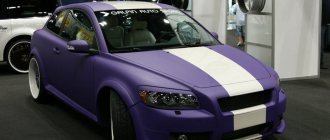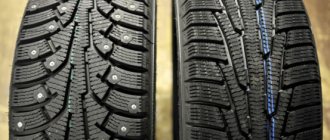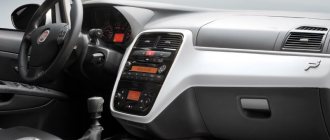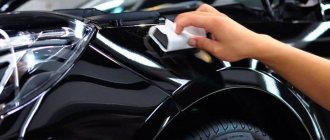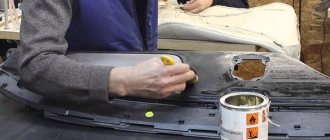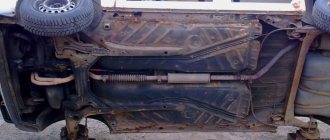16.10.2019
| (Votes: 1, Rating: 5) |
Issues discussed in the material:
- What are the pros and cons of treating a car with liquid rubber?
- What are the stages of coating a car body with liquid rubber?
- How to remove liquid rubber from a car
- What determines the price of painting a car with liquid rubber?
If your car's paintwork is not in the best condition, but you don't want to paint it with enamel or cover it with vinyl film, then liquid rubber for your car is what you need. Another name for this coating is plastidip, or liquid vinyl. Some car owners think that covering a car with plastidip is unprofitable, because the price of the material and painting is quite high, and the coating is short-lived. The other half of car enthusiasts are confident that liquid vinyl will last a long time even when applied to wheels, of course, if you follow the painting technology.
The essence of covering a car with liquid rubber
This material is used not only for painting the entire car. Liquid rubber is suitable for car arches, as well as covering body elements. By the way, it would be more correct to say that plastidip is applied or covered with it on the car, and not painted. To work with this material you will need a regular sprayer. When the coating becomes hard, its properties will be similar to traditional film. If desired, it can be easily removed.
Plastidip is a waterproofing with bitumen-polymer and water components that is sprayed onto the surface. How is this material produced? Bitumen and water are driven through a colloid mill. During this process, the mixture is ground down to a few micrometers. Then the suspension is enriched with polymers, as a result the material acquires the properties of latex.
Previously, liquid rubber for cars was black. However, today there are plastidips of any shade, from metallic to “chameleon”.
Liquid rubber for a car is classified depending on:
- release forms, in cans or jars;
- manufacturer. High-quality material is produced by the following companies: Plasta Dip, Rubber Dip, Arizona, Mibenco, Rubber paint, Kudo, Runway;
- shades: standard color, chameleon, camouflage, pearlescent;
- type of coating: transparent, matte or glossy.
If you choose matte liquid rubber for your car, you can completely change the image of your car. The car will become stylish, but at the same time more aggressive. It will attract the attention of passers-by and other motorists, indicating the good taste of its owner. Despite the drastic changes that can be achieved with matte plastidip, you will not have to make changes to the title if you decide to matte the car, leaving the same shade. It is also allowed to repaint the area up to 40%.
Most often, colored liquid rubber for a car is matte. Glossy plastidip is best to buy if you are repainting your car in metallic, pearlescent, luminescent or “chameleon” shades. Gloss always looks good, but in cloudy weather this coating looks most striking, so your car will stand out from the crowd of other cars.
What is transparent plastidip used for? For example, you can use liquid rubber on car sills to protect them from damage. This coating is also used to make the surface of the car glossy. Transparent plastidip is suitable for protecting the radiator grille, rims and other parts that may be damaged during operation.
Symbols and lines on tires
The print on the tires significantly improves their design. It is enough to highlight the letters of the name of the tire company/model and they already look more impressive. The print itself plays an important role in design. Writing is in some ways a fine art.
But you can decorate tires not only with letters. There are also lines and symbolism. As a rule, the raised outlines of the lines along the tire bead are already present. It is enough to highlight them with a contrasting color, for example, with the same marker for rubber.
Pros and cons of treating a car with liquid rubber
Painting a car with liquid rubber helps protect the body from damage. Vinyl coating does not give this effect. Plastidip is able to hide paintwork imperfections, as well as prevent the appearance of cracks, scratches and chips. What other advantages does this material have:
- many textures, that is, you can create both matte and glossy finishes;
- plastidip is elastic, does not allow water to pass through;
- not afraid of direct sunlight;
- you can paint the entire car completely or individual elements, for example, only arches, sills;
- protects the car from the harmful effects of detergents;
- emphasizes the good taste and status of the car owner;
- using plastidip, you can paint even hard-to-reach elements, for example, restore the original appearance of a tire;
- simple application technology, so this material is suitable for use in all cases.
Despite the above advantages, liquid rubber for cars also has disadvantages. For example, the coating will have to be renewed after 24 months, and the first signs of wear may appear within a year. What other disadvantages does plastidip have:
We recommend
“Liquid glass for cars: effective protection and attractive appearance” Read more
- painting a car with this composition will not be easy for a beginner;
- Particles of asphalt and bitumen should not fall on the painted surface, so it is better not to drive in places where road work is being carried out;
- When going to a car wash, you should inform the employees that the car is coated with plastidip. If the washer applies too much force, it may damage the rubber coating;
- It will be quite difficult to wash off dirt from the body; after soaping, stains may remain;
- Avoid contact with chemicals, as this may cause rubber paint to dissolve;
- Do not cover the body with wax or wax-containing substances;
- It is necessary to carefully wash the car, carefully get out of it, your passengers must be warned so that they do not tear off the covering from the sills.
Liquid rubber can leave sticky marks on your car. They can only be removed by polishing the body.
Stages of coating a car body with liquid rubber
The most important advantage of liquid rubber is that it is easy to use. What is the technology for using plastidip? If you decide to paint the car yourself, remember that you must follow the following sequence:
- prepare the car;
- preparing the composition;
- apply it to the surface.
Do you want to avoid waste of material, as well as prevent the appearance of sagging and dust? Then you should start painting from the roof, then move on to the racks. After this, you can paint the bumper, trunk lid, doors, fenders, and last but not least the hood.
To ensure you are pleased with the result, apply the composition in a dry, dust-free room at a temperature of about 20 °C.
1. Preparing the car
First of all, you need to buy liquid rubber for painting your car. Then we start preparing the car. It must be washed and dried using a hairdryer, because even a few drops of water on the surface will cause the liquid rubber to swell.
Let's start degreasing the surface. Next, using paper and film, you should cover those parts of the body that you are not going to paint:
- We install cardboard sheets behind the radiator grille and bumper. We dismantle the wipers, seal the windows, windshield, mirrors;
- dismantle registration numbers;
- We seal the wheels completely if you are not going to paint the rims. If they are also covered with plastidip, then we cover only the brake discs and pads.
2. Preparation of the product
Let's proceed to the second stage. Here you will definitely need a special mask - a respirator, so as not to inhale microparticles of liquid rubber when sprayed.
We take the solvent and add it to the plastidip in a 1:1 ratio, thoroughly stirring the composition. To apply the material you will need a special tool - a spray gun.
We pour the composition into it and proceed to adjust the sprayer. We set it up so that the supply of material is minimal, we try it on any surface that we don’t mind ruining. We adjust the spray gun until the coating becomes even.
3. Car surface painting
When the color of liquid rubber (it doesn’t matter, metallic or “chameleon”) matches the shade of the car, then only 3-5 layers are required. However, if the colors are very different, then transition layers will be needed to achieve the desired shade.
For example, you cannot apply red or black composition without a transition shade. After all, a saturated tone of the desired color will not work. Remember that if over time you want to change the color of your car, you can simply remove the plastidip like a film.
Apply the first layer from a distance of 12–16 cm. We act carefully, in a back-and-forth motion, holding the spray gun at an angle of 90 degrees.
The first layer will be quite thin and half transparent. We wait 10–15 minutes for the liquid rubber to dry completely.
We begin to apply the second layer. Carefully spray the material so that the edges and curves of the body are covered. The coating is 70% transparent. We wait a quarter of an hour for the plastidip to dry. Apply the remaining layers in the same way.
We recommend
“Diagnostics of the suspension: how to do it correctly and why” Read more
Before you start spraying the last layer, you should wait 1 hour. No need to use hair dryers or fans to speed up the drying process.
Upon completion of work, remove the protective paper and film. Now the car should sit for a day, after this time the liquid rubber will dry.
Note! You cannot visit a car wash for 3 days after painting.
If you find any defect, simply apply another layer of plastidip. This coating protects the body from corrosion, scratches and chips.
Cars painted with liquid rubber look catchy and impressive, stand out from the crowd of other cars, and attract attention.
How much liquid rubber is needed to paint a car? It is easy to find out the required amount of material: per 1 square meter of surface you will need 75 ml of the composition to make 5 layers. This applies to the external elements of the body. If you want to paint the car interior, liquid rubber should be applied in 3 layers. When you need to apply plastidip to rims with a radius of 16 or more, you will need 5-6 standard cans. If the discs are size 15 or smaller, then only 4 cans will be enough.
How to remove liquid rubber from a car
Companies involved in the production of liquid rubber for cars claim that it is easier to remove the coating than to apply it. Follow the following sequence if you want to remove plastidip:
- Pry the material from the edge and smoothly pull it up.
- The film will begin to peel off, so carefully grab it and slowly move on. Act smoothly, without jerking.
- The material must be completely removed from the entire area in one piece.
- If small streaks or residue remain in the grooves and grooves, take a piece of dry microfiber cloth. There is no need to apply any additional product, just wipe off the plaque.
- When the car body is cleared of plastidip, go to a car wash, where the car will be cleaned under pressure and using special auto chemicals.
How to wash off liquid rubber from a car if it was applied to the surface incorrectly? For example, the layer may not be thick enough, and then it will not be possible to remove the film. It simply will not be removed in one piece, and it will become impossible to complete such work. What to do in such a situation?
If you cannot remove the plastidip manually in one piece, use DipDissolver, a specially designed remover for this purpose. How to use this tool:
- Apply the product to the plastidip with a spray bottle and wait a quarter of an hour;
- then apply the second layer;
- wait 5 minutes and remove the liquid rubber by directing a stream of water under high pressure onto the surface. There is one caveat: with this method of removing the coating, white stains may remain on the black surface, so you should be careful.
You can use another composition to remove liquid rubber from a car. In this case, you should study the instructions for use. The most important thing when working with plastidip is to adhere to the application technology. Then the layer will be thick enough, and you will be able to remove it quickly.
Tips for processing thresholds with your own hands
The most accessible method that does not require special qualifications is the use of liquid rubber. This product is offered in automotive stores inside aerosol cans, so applying it evenly does not require special effort, skill or skill.
Painting should be carried out indoors with a temperature of 16-22 degrees Celsius, in which there is no dust. The lighting there should be as comfortable as possible.
Work must be carried out in the following sequence:
Many experienced car enthusiasts recommend washing the car the day before painting, leaving the car overnight in the room where the painting work will be done.
It should be remembered that if there are areas of contamination left after work, they must be removed immediately using available means.
What determines the price of painting a car with liquid rubber?
When you use liquid rubber for a car, the material consumption directly affects the cost of the work. What else does the total amount consist of:
- cleaning the body, dismantling some elements: lights, bumpers, headlights, door handles;
- applying a degreaser;
- restoration of body elements, if necessary, removal of corrosion, soldering, welding, stretching and applying putty;
- grinding work, applying primer;
- directly applying liquid rubber to the car;
- again sanding and then polishing work.
We recommend
“Diagnostics of automatic transmission: to prevent serious damage to the car” More details
Each applied layer of material must dry for 15 minutes, the last layer will dry completely after 1 hour. Experts do not recommend using hair dryers and fans to speed up this process. Thus, the total application time is 3 hours. It will take a certain amount of time to prepare the car and carry out repair work, if required. After this, it will take a day for the liquid rubber to dry completely.
The price of the work is determined by the class of the car, as well as how complex the painting is (number of layers, multi-color, etc.). On average, you will spend from 20,000 to 50,000 rubles. A more accurate amount can be calculated if you know the model of your car and the selected shade of plastidip.
Possible mistakes
When carrying out work on applying a protective layer to the thresholds, one should be guided by the practical experience of many motorists. Thanks to this, you can avoid the most common mistakes:
It is better to select materials of a suitable color with an external paint coating.
Liquid rubber has gained quite wide popularity among Russian motorists. The main reasons for this choice are the availability of materials, ease of application, and good results.
Source
Is it worth covering the car body with liquid rubber: opinions of car owners
- You need to think.
“In general, the idea is not bad. I wanted to paint the car, but so far I’ve only decided to paint the rims, I’ll see what happens. Of course, you must be prepared to pay a large sum for the material. For example, my car requires 2 x 5 liters to ensure an even coating. You will also need solvents, a spray gun and a compressor. In general, you will have to spend a lot of money.You can’t fool yourself: liquid rubber for a car is not paint, it won’t last for many years, it will start to peel, swell, and get scratched. Plastidip will last a maximum of 2 years. And you yourself will want to remove the coating. But if you follow the application technology and properly prepare the surface, you will be pleased with the result. In any case, it’s worth considering this painting option.”
- Just a scam for money.
“I think these expenses are pointless. Besides, you are not going to drive the same car for the rest of your life. Nowadays it’s like everyone else does: they take a car, use it for 3 years and sell it. During this time nothing will happen to her. I'd rather spend the money on something else." - I'm experimenting!
“Some people think that liquid rubber is not needed for a car, because there is a film. But these two materials are not similar to each other. And the advantages of liquid rubber are obvious: - To cover the body with film, it will take at best 7 days, and to paint a car with plastidip, you only need 5 hours, including preparatory work.
- If the car is covered with this material, corrosion does not form on the body and chips do not appear.
- Liquid rubber can be used not only for a car; it can even be applied to a battery.
- Plastidip is easily removed, the paintwork does not deteriorate.
- The cost of painting is 2.5 times less.
- Liquid rubber is pleasant to the touch and looks great.
When cutting the film on the body, the paintwork deteriorates.
I'm happy with this material. Friends painted their Infinity Land Cruiser Prado cars white with plastidip in the summer. And in winter they want to repaint it black.”
“I’ll tell you how my car was painted. Plastidip was applied to the roof. At first everything suited me. And then washing became too problematic. After all, in the summer the sun evaporates water, making it impossible to wipe the surface without leaving streaks. And also, if a branch or anything else touches the coating, a stripe will remain. I personally wiped the roof and touched the plastidip for hours, a little of the material came off. I don't recommend using it."
“I recently bought a car and immediately wanted to do some styling to make it look cool. This is how my acquaintance with liquid rubber began. At first it seemed to me that this was all nonsense and that the plastidip would come off the surface in a week. I was also afraid that it would be impossible to remove it.
First I covered the dashboard linings with brown liquid rubber, first I painted one part, then the other. I liked the application technology: we spray a little composition, wait until the first thin layer dries, to which the subsequent ones will cling.
We recommend
“The car smells like rubber: reasons for the smell and ways to eliminate it” More details
You can also change the texture. If you want a smooth coating, keep the can close. To achieve a larger texture that imitates leather, place the can further away. During the application process, no drips form, the material levels itself out, and in the end everything looks great.
After 6 months I decided to paint the bumper and mirrors. I bought liquid rubber in the same color as the car - red. I really liked it the first time. But due to the fact that the mechanical load outside is greater than inside, the bumper became scratched after some time due to dirt and stones. Liquid rubber had to be removed from the car. By the way, the layer was removed easily and quickly, literally in five minutes.
My opinion is this: liquid rubber is excellent for painting the interior parts of a car. But the body is best treated by specialists, and not from a spray can. The master uses a spray gun, the layer is thick, and you can choose almost any shade.”
